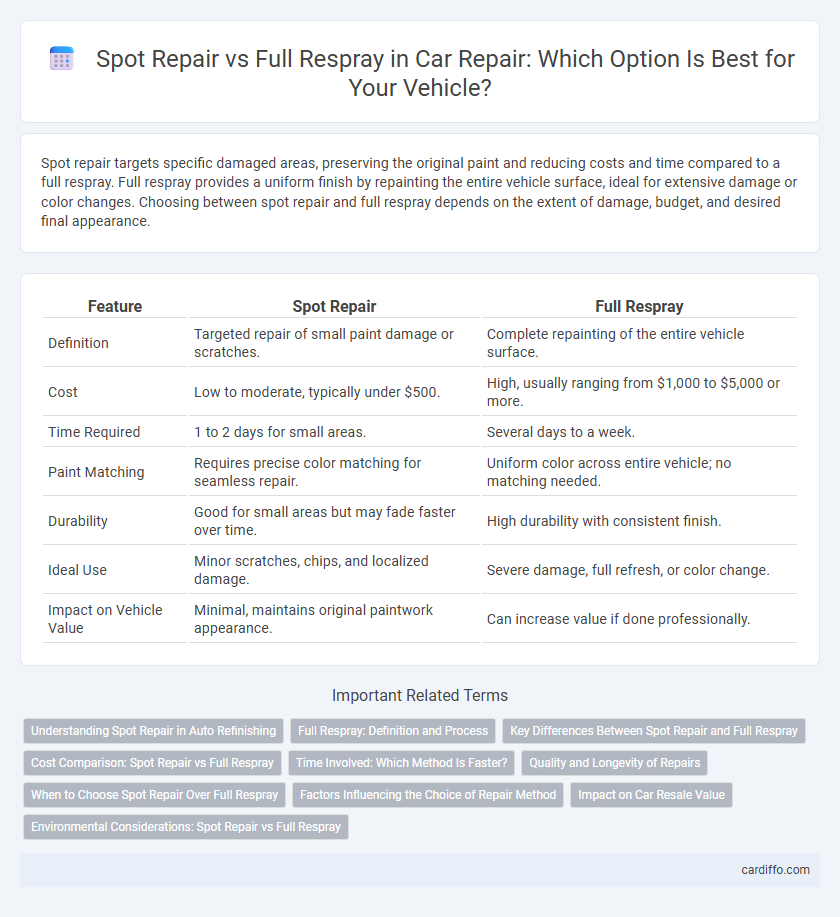Spot repair targets specific damaged areas, preserving the original paint and reducing costs and time compared to a full respray. Full respray provides a uniform finish by repainting the entire vehicle surface, ideal for extensive damage or color changes. Choosing between spot repair and full respray depends on the extent of damage, budget, and desired final appearance.
Table of Comparison
| Feature | Spot Repair | Full Respray |
|---|---|---|
| Definition | Targeted repair of small paint damage or scratches. | Complete repainting of the entire vehicle surface. |
| Cost | Low to moderate, typically under $500. | High, usually ranging from $1,000 to $5,000 or more. |
| Time Required | 1 to 2 days for small areas. | Several days to a week. |
| Paint Matching | Requires precise color matching for seamless repair. | Uniform color across entire vehicle; no matching needed. |
| Durability | Good for small areas but may fade faster over time. | High durability with consistent finish. |
| Ideal Use | Minor scratches, chips, and localized damage. | Severe damage, full refresh, or color change. |
| Impact on Vehicle Value | Minimal, maintains original paintwork appearance. | Can increase value if done professionally. |
Understanding Spot Repair in Auto Refinishing
Spot repair in auto refinishing targets specific damaged areas, minimizing paint use and reducing costs compared to a full respray. This method preserves the original factory finish on unaffected panels, ensuring color match and blending through advanced techniques like feather edging and blending solvents. Spot repairs deliver efficient restoration for minor dents and scratches without compromising the vehicle's overall appearance.
Full Respray: Definition and Process
A full respray involves completely stripping the vehicle's existing paint and applying a new coat to restore or change its color uniformly. The process includes thorough surface preparation such as sanding and priming to ensure paint adhesion and a smooth finish. This method provides comprehensive coverage, effectively eliminating blemishes and imperfections for a like-new appearance.
Key Differences Between Spot Repair and Full Respray
Spot repair targets specific damaged areas, utilizing localized paint matching and blending techniques to restore the original finish without affecting the entire panel. Full respray involves stripping and repainting the entire vehicle or panel, ensuring uniform color and gloss but incurring higher costs and longer labor times. While spot repair is cost-effective for minor scratches and chips, a full respray is preferred for widespread damage or complete color changes to achieve consistent results.
Cost Comparison: Spot Repair vs Full Respray
Spot repair typically costs significantly less than a full respray, with prices ranging from $50 to $500 depending on the damage size and location. Full resprays can cost between $1,000 and $5,000 or more, influenced by factors such as vehicle size, paint quality, and labor intensity. Choosing spot repair offers a cost-effective solution for minor blemishes, while full respray ensures complete color uniformity but requires a higher budget.
Time Involved: Which Method Is Faster?
Spot repair requires significantly less time than a full respray because it targets only the damaged area, minimizing preparation and paint curing durations. Full respray entails comprehensive sanding, priming, and multiple paint layers over the entire vehicle surface, extending labor hours and drying time. Consequently, spot repairs are optimal for minor imperfections when speed is a priority.
Quality and Longevity of Repairs
Spot repair preserves the original paint finish, ensuring high-quality blending and a seamless appearance while minimizing the risk of color mismatch. Full respray offers comprehensive coverage, which can enhance the uniformity and long-term durability of the repair, especially on larger or extensively damaged areas. Choosing the right method impacts both the visual outcome and the longevity of the repair, with spot repairs ideal for minor blemishes and full resprays better suited for significant damage.
When to Choose Spot Repair Over Full Respray
Spot repair is ideal when addressing minor damages like small dents, scratches, or localized paint chips, preserving the original paint and reducing overall costs. It allows for a quicker turnaround time compared to a full respray, making it a practical choice for isolated imperfections without compromising the vehicle's appearance. Opt for spot repair when the damage is contained to a limited area and a seamless color match is achievable.
Factors Influencing the Choice of Repair Method
Choosing between spot repair and full respray depends on factors such as the size and location of the damage, the vehicle's paint type, and budget constraints. Spot repair is ideal for minor scratches or chips confined to small areas, preserving original paint and minimizing cost. Full respray is necessary for extensive damage, color mismatches, or when restoring the entire panel's finish for uniformity.
Impact on Car Resale Value
Spot repair preserves original paintwork and factory finish, maintaining higher car resale value by avoiding mismatched colors or texture variations. Full respray can significantly reduce resale worth if not done with exact color match and professional quality, potentially signaling extensive past damage to buyers. Choosing spot repair enhances resale appeal by keeping the vehicle's aesthetic integrity intact and minimizing repair visibility.
Environmental Considerations: Spot Repair vs Full Respray
Spot repair minimizes environmental impact by using fewer materials and reducing paint emissions compared to a full respray, which involves sanding, masking, and applying paint over the entire surface. The reduced use of solvents and lower energy consumption in spot repairs also contribute to less airborne volatile organic compounds (VOCs), helping to improve air quality. Choosing spot repair over full respray supports sustainable practices by decreasing waste generation and conserving resources.
spot repair vs full respray Infographic

 cardiffo.com
cardiffo.com